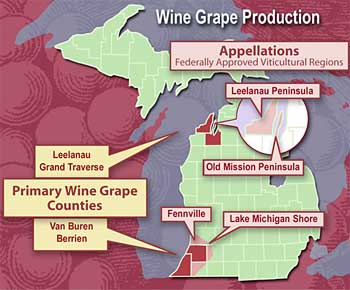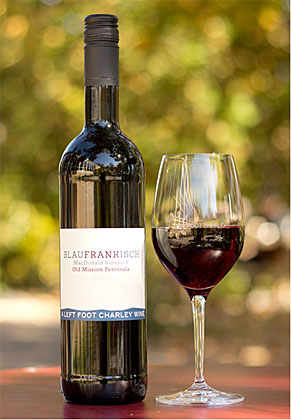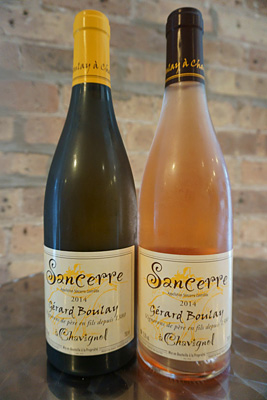| July 2015 | ||
| « Apr 2015 | News | Aug 2015 » |
July 29, 2015
Blaufrankisch, Austria's spicy red rockstar-in Michigan?
 Michigan is deep in the throes of a winemaking frenzy, with the area under vine doubling in just the last ten years. Grapes have long played a part of Michigan’s produce; the state is a major supplier of Concord grapes to Welch’s Juice Company. But making wine from those grapes is a different story: winemaking has historically happened in fits and starts, and not until recently has it begun to achieve any real success.
Michigan is deep in the throes of a winemaking frenzy, with the area under vine doubling in just the last ten years. Grapes have long played a part of Michigan’s produce; the state is a major supplier of Concord grapes to Welch’s Juice Company. But making wine from those grapes is a different story: winemaking has historically happened in fits and starts, and not until recently has it begun to achieve any real success.
Winemaking in the state was first documented in 1679 when French explorers made wine from wild grapes growing along the Detroit River (Merci, the French!). These were not vitis vinifera, but native Concord, Niagara, and Catawba grapes, known to display foxy, unsavory aromas when fermented. According to a Michigan Wine Industry research report, a commander sent word back to France of “the wild vines heavy with grapes, of which the forest rangers say they made a wine that, considering its newness, was not at all bad.” “Not at all bad” is probably the best that could be said of these wines, and indeed of most of the wine produced up until the 1960s, when pioneer grape growers began to plant French-American hybrids. Warner Vineyards and St. Julian Wine Company were among the first, with many soon to follow. In 1969, Tabor Hill Winery planted the state’s first documented European vinifera varietals, Chardonnay and Riesling. From there, winemaking has taken off like gangbusters, with about 2,650 acres currently devoted to wine grapes, making Michigan fifth in wine grape production in the U.S. Cool-climate varietals and dessert wines tend to be the most successful.
It’s no surprise, then, that Blaufrankisch, Austria’s spicy red rockstar, is a real up-and-coming contender on the Michigan wine scene. Blaufrankisch is known for good color, tannin, and acidity. It has racy personality and the potential to age for a relatively long haul. Its home in Austria is very close in latitude to Traverse City (48.2000 N vs 44.7681 N), and climatically similar. Michigan’s unique “lake effect” can help protect vines with winter snow, which can slow down bud break for this notoriously early budder. The grape is very prone to spring frost, so a later bud break is an important layer of protection. The later budding also extends the growing season by up to four weeks.
 The Left Foot Charley Urban Winery in Traverse City makes a killer version with a touch of Pinot Gris from Old Mission Peninsula. Founder Bryan Ulbrich has teamed up with the Bill and Margaret MacDonald Vineyard to grow a half acre of this succulent grape in sandy loam soil. The 2013 is a pale purple-red in glass with a translucent magenta rim. It starts out very tight, but opens up with air to reveal baking spice, black raspberry, lavender-vanilla, mulberry, and black pepper. The palate continues on a note of berries: brambly, black raspberry and blackberry. The tannins are integrated and polished. This would be fantastic with a Greek smorgasbord: olive tapenade, feta cheese, hummus, pita, and baba ganoush.
The Left Foot Charley Urban Winery in Traverse City makes a killer version with a touch of Pinot Gris from Old Mission Peninsula. Founder Bryan Ulbrich has teamed up with the Bill and Margaret MacDonald Vineyard to grow a half acre of this succulent grape in sandy loam soil. The 2013 is a pale purple-red in glass with a translucent magenta rim. It starts out very tight, but opens up with air to reveal baking spice, black raspberry, lavender-vanilla, mulberry, and black pepper. The palate continues on a note of berries: brambly, black raspberry and blackberry. The tannins are integrated and polished. This would be fantastic with a Greek smorgasbord: olive tapenade, feta cheese, hummus, pita, and baba ganoush.
Unfortunately, Midwest winters can sometimes get the better of the grape (as they can get the better of all of us). The 2014 winter was not kind to the Left Foot Charley’s Blaufrankisch, so there won’t be another bottling until the 2016 vintage, which means it won’t be released until 2018. Fortunately, the 2013 is downright delicious, so stock up, get it while you can!
Written by Kate Soto
July 15, 2015
FEATURED: Summer Sipping Primer 2015: Weirdo Whites
Let 2015 be the summer of the weird, obscure white. Let the Garganega be flowing. Give your Chardonnay a break. Put the Sauvignon Blanc back on the shelf. Be that guy or gal who brought the Godello. Let this be your calling card. Spicy mango fish tacos on the menu? Is your best friend roasting a duck? Show them how they do it in Alsace with an ambrosial Muscat. We have a stellar lineup of offbeat wines that are just aching to join you at your next summer BBQ. Here are a few to wet your whistle.
July 09, 2015
Gerard Boulay - 2014's Will Have You Singing
Chavignol is a tucked-away hamlet in eastern Loire Valley, surrounded by slopes of walnut orchards and vineyards. The village is home to about 200 people, a mind-blowing goat cheese—Crottin de Chavignol—and a vineyard that’s one of the very best in Sancerre, Monts Damnés. It’s also home to Gerard Boulay, an essential Sancerre producer with family winemaking roots in the village that date back to 1380.
Gerard and his wife, Lucie, draw on their family’s tradition to farm their 9 hectares: manual harvest, no pesticides, minimal intervention in the cellar, native yeasts, no filtration—just like their ancestors had been doing for centuries. The Kimmeridgian limestone soil where there grapes are grown (“terres blanches” thanks to the white chalky clay component) is similar to what you’ll find in Chablis—and there’s a kinship to that chilly northern Burgundy region in Boulay’s wines. You’ll find more in common with a linear, sleek Chardonnay from Chablis than a Sauvignon Blanc from warmer climes like New Zealand or California. According to the Washington Post, “The Kimmeridgian soil yields fruitier, much more direct, pointed wines, aggressive in acidity and extremely age-worthy. Some of the top wines from a great year like 2010 can be laid down for 30 years.” (“With Sancerre, Soils Matter,” 07/2012)

Boulay has holdings in the most celebrated vineyards of the village: Clos de Beaujeu, la Cote, and Monts Damnés, including a cuvee made exclusively from the oldest, steepest vines in Monts Damnés called “la Comtesse.” Vines average 45 years in age. It’s no wonder that his wines express such deep connection to the pedigreed soil of Chavignol. In fact, help yourself to a hunk of Crottin de Chavignol while sipping Boulay’s wines and you’ll be singing the praises of this hamlet for years to come.
Written by Kate Soto
